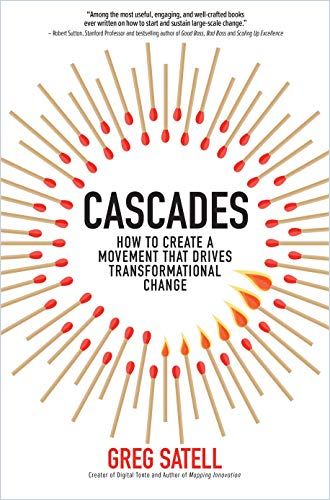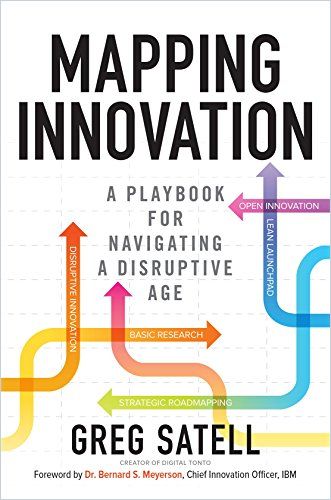“Transformational Change Is Always about Small Groups United by a Shared Purpose.”

Greg, most transformational initiatives in organizations fail, and even if they don’t generate any productive outcome, they likely cause turmoil and turnover. This has been going on for years now, possibly decades. Can you quickly explain to me why the problem persists?
Greg Satell: In fact, more than two-thirds of those initiatives fail! Roughly 60 percent of employees experience change fatigue, about 50 don’t understand the initiatives they’re being asked to take part in, and approximately 30 percent don’t want them to happen anyway. That is what survey over survey reveals. Now, why is that? Let me explain the main issue with two typical examples: Someone in your office attends Agile training, learns about the Agile Manifesto, embraces it, and believes it works. They return to the organization, return to their office, and say something like, “Stop everything! It’s all wrong. Stop it right now! We need to do something very, very different and in a different way.” In most cases, these people get shunned – and become cynical and claim that “nobody wants change.”
Take-Aways
- Change always comes from the outside and incurs resistance.
- Ideas about change are propagated socially through peer networks, and it’s a leader’s job to help those groups connect and inspire them with a sense of shared values.
- There are five categories of change resistance: lack of trust, change fatigue, competing incentives or commitments, switching costs and identity, dignity, or sense of self.
And here is example number two: Someone high up in the organization has an idea for a transformational initiative. They tap a high-potential employee, telling them it’s an ample opportunity. They can choose their budget and have full executive backing, but it’s urgent. They even hire outside consultants, create a communication plan, hire trainers, and launch with a big party. Yet, six to nine months later, they realize they’ve been quietly undermined and sabotaged, everything has run aground, and the executive sponsorship is shaky.
By this point, a lot of money has been wasted, and the person is probably in therapy, experiencing extreme anxiety, with their career taking a hit. None of this had to happen.
Why not?
If we follow the evidence, which is the good news, we know four things about change based on decades of research and hundreds of studies. First, change always comes from the outside and incurs resistance. If you don’t have a plan to deal with resistance, you’re not being serious. Second, there is a common and persistent KAP gap, meaning shifts in knowledge and attitudes don’t necessarily result in changes in practice. Third, change follows an S-curve: it starts slowly and hits an inflection point – I’ll come back to that -, triggering a cascade and leading to exponential acceleration. Fourth, ideas about change are propagated socially through peer networks.

What does that tell us to do in your example cases?
First, if you attended Agile training, coming back with an idea from the outside, be prepared for resistance. Second, focusing on a communications strategy from an outside agency is not as important as many think: Shifts in knowledge and attitudes won’t necessarily drive a shift in practice. Third, if you know change follows an S-curve and starts slowly, why do a big launch event? The tipping point tends to be within 10 to 20% participation, so focus on enthusiastic individuals who want the change to work. Work with them on an initial keystone change, build a track record of success, and then start communicating. Fourth and last, since we know ideas are propagated socially, empower people to bring others in. Change is not about incentives or psychological techniques. It’s about empowering people to make the change work for them so they can bring others in, who can bring in others. And because most change initiatives in organizations and companies worldwide do not see this and do not act accordingly, they fail. It’s as simple as that.
So, the technique most people, especially leaders, use to “convince” people of the necessity of change and thus drive it – persuasion – won’t work?
Anyone who’s ever been married or had kids knows how hard it can be to convince even a single person of something they don’t want to be convinced of. If you think you’ll convince hundreds or thousands because you came up with a nice slogan or idea, your fundamental fallacy or misconception is that large-scale change is simply the persuasion of one person scaled up. But that’s not true.
Ideas about change are propagated socially – through social bonds. And the urge to persuade is, therefore, a red flag: It means you have either the wrong people or the wrong change.
What does that mean in concrete terms?
We know from decades of research that the best indicator of what we think and do is what the people around us think and do. Majorities don’t just rule; they also influence. That’s why we have inside jokes in an office. This effect goes to three degrees of social distance, not just our friends and friends of friends, but even friends of friends of friends, people we don’t even know, influence us in ways we’re generally unaware of. I might convince you, Michael, of something, but chances are when you go back and are once again embedded in your social networks, if your social networks hold a different idea, you will get persuaded right back.
So, as you describe it in Cascades, there is a strategic conflict between the new and the old – and the old, for example, established processes, products and hierarchies in organizations, in most cases, have a power advantage. How do you overthrow it?
It’s not an overthrow. Because usually, the initiatives for change come from the top. Another fundamental fallacy around change is that it comes from the top or must be grassroots. Change isn’t top-down, and it’s not bottom-up. It’s always side-to-side, from active support to active resistance, at every level of the organization. So, let’s talk about adaptation instead of overthrow: What is true is that change is always a strategic conflict between some alternative future vision and the status quo. And there are always sources of power holding the status quo in place. We call them pillars of support. They support the present state, and these sources of power always have an institutional basis.
So, how do you deal with them regarding the desired adaptation?
Map them.
When figuring out a change strategy, one of the first things is to identify which sources of power or institutions support the status quo, which support the future state, and which are uncommitted and on the fence.
These institutions can be divisions within an organization, functional groups, external stakeholders like customers, partners, regulators, educational institutions, industrial or professional associations, communities, religious groups, or the media. Anyway, you want to identify what sources of power or institutions can affect the outcome because they will be your strategy’s targets.

So, I’m not focusing on individual representatives of these institutions, even influential ones?
A quick clarification: The pillars of support are institutions, not people. It’s crucial to make the distinction. For instance, if you want to create change in your educational system, there are different stakeholders: students, teachers, parents, teachers’ unions, school boards, local governments, and businesses. But those stakeholders are very varied. In this case, you might decide to mobilize parents, teachers, and students – people within the institutions to influence institutions, but with their specific set of ideas, values, needs, and worldviews. Only when you have understood what the framework looks like can you bring selected groups together. In companies, for example, if you are a middle manager who wants a change in an HR system but lack the power to change it, don’t knock at HR’s doors every quarter to repeat your request. Instead, for example, present your idea to the workforce at the next company kickoff, where inputs are requested, heard, and valued. Or, if possible, use a specific tool that solves the problem for you on your expenses first, and then tell other middle managers about it when it comes to best practices in your monthly cross-departmental meeting. There are various ways you can leverage. Either way, the goal is to create a majority to knock on HR’s door for you. May I give you two powerful examples of how this works in detail?
Please go ahead.
The first is from Experian. When they got a new CIO, Barry Levinson, and he spent his first couple of months talking to customers, they all said they wanted real-time access to data. Experian, a big data company, had its primary business as a credit bureau. The major customers, banks, wanted real-time access to data. Now, Barry, being a tech guy, knew from a technology point of view that meant shifting from on-premises computing to the cloud. Technologically, the solution is clear. But Barry is a bright and seasoned executive. He knew there would be trouble. As CIO, he had full authority to make this decision, but he knew the decision to go to the cloud would not fly. There were reasons for people to hate this idea, such as the business transformation, concerns about cybersecurity, and the switch from waterfall to agile development. Instead of another change announcement or an extensive kickoff campaign, he didn’t do any of that.
What did he do?
He helped identify project managers who were enthusiastic about building cloud-based products, providing them with a co-opt resource called the Center of Excellence. If you were a product manager wanting to develop a cloud-based product, you’d get extra help. Finally, he started with a keystone change – internal APIs, Application Programming Interfaces. No change in the business model was needed, and there was no additional cybersecurity risk. Only APIs, not open to the public – and his programmers started building products! People within the company could see the value immediately, and that’s how he gained traction, finishing the transformation within three years and making some of Experian’s most profitable businesses.
And the second story?
The second story is very different. It’s about a middle manager at Procter & Gamble who solved a problem and won an internal award. He wanted to turn the learnings into a program for the company, and with an executive mentor, he followed the steps in Cascades. Instead of trying to change everyone at once, he grew his movement for process improvement to 2500 people within 18 months, hitting the tipping point. Today, PxG, the resulting program, involves more than 60,000 employees at Procter & Gamble. Even for them, 60,000 is a significant number. And remember: He was nobody, a middle manager – so if he can do it, anybody can do it.
Ultimately, you say, empowerment is imperative.
Yes. That’s why I always say:
Start with a majority. Even if it’s three people in a room of five, you can continually expand the majority out.
Once you’re in the minority, you will feel immediate pushback. And if you start feeling that pushback and your reaction is to try and persuade that other person, you’re in a conflict. Now, regarding the nature of empowerment, it’s crucial to note that this is not about financial incentives or budgets or so. My examples were about resources for consulting, help or support.
What other types of empowerment are there?
This is about optimal resources that make life and work for majorities easier, better, faster, more affordable, or more pleasant. For example, think about TED: You’ve got 14,000 TEDx events worldwide. You’re talking about thousands upon thousands of people investing their money and time – about untold millions of dollars in people, hours, and effort to support the conference. But that’s not why people are doing it. They’re doing it for their own reasons. The people at Experian weren’t doing it for Barry Levinson. They were doing it for themselves because he was helping them do what they already wanted to do. It was their success that brought others in.
So, speaking of success: In Cascades, you write about different change process phases. Can you elaborate on that?
Big change processes tend to have three phases. So, the initial phase before you’ve hit the tipping point is 100% about empowerment. Once you pass that tipping point and you’ve gained traction, that’s when you can start communicating. At that time, it becomes more of a performance effort, a performance issue. That’s why I call it the “engagement phase.” After, let’s say, 75%, you enter the “victory phase” – at this point, the desired changes take root.
You already mentioned that this is not a top-down or bottom-up issue. Still, I think hierarchies play a significant role here. Is there any rule of thumb from your perspective on dealing with hierarchies during those stages of change processes?
I wouldn’t say hierarchies are the problem because you will run into that problem at every level of the organization. I speak to executives worldwide, and senior leaders tell me they want change everywhere I go. They want to lead their organizations in a direction that means change. But the rank and file won’t go along with it. Everywhere I go, I talk to people lower down in the organization as well, and they say they want change, but “the guys at the top won’t go along with it.” So, the idea that nobody likes change just isn’t accurate. What’s true, though:
People don’t want others’ change and don’t like change imposed on them.
So, it’s not so much a hierarchical issue. The issue you’re getting at is how to overcome resistance. That’s why I suggest going through a resistance inventory.
What is in it?
My research has identified five categories of change resistance. The first is lack of trust: People don’t trust you or trust the organization. That is difficult to manage in many cases, especially if they’ve seen many initiatives fail. The second is change fatigue, which we already discussed: People are being asked to change many things and have a lot of work to do. Competing incentives or commitments is the third – for example, being paid to do one thing and asked to do something very different. Or there can be an internal commitment, for instance, a manager who wants to delegate more but also likes to see herself as a hands-on manager. The fourth category is switching costs: There will always be some switching costs with any change, which is perfectly rational. But the last category is irrational: Resistance that has to do with identity, dignity, or sense of self.
In other words, one can ask people to change what they do, but we’re off-track when we ask them to change who they are.
Yes. Humans all form attachments to people, ideas, and other things. When those attachments are threatened, we act in ways that don’t reflect our best selves. We all do it. Just because people work this way doesn’t make them bad people. But it doesn’t change the fact that anytime we set out to make a significant impact, there will always be some people who don’t like it. They’re going to act in ways that undermine us and are dishonest, underhanded, and deceptive. Once you accept that, you can start to move forward.
So, ignore them and focus on the majority?
I wouldn’t say ignore them because you want to listen to them; those people are usually silent.
Skeptics are good. People who ask questions are good. They can be helpful. You can set them up as a red team to point out flaws. But you want to hear their take because that’s how you identify shared values. If you can find shared values in how your opposition attacks you, you have a solid tool to unite them behind your idea.
If you cannot see them, instead focus on shared values among your focused groups. Engaging with people actively trying to undermine you is unlikely to result in a good outcome and will likely frustrate and exhaust you. And by the way: If they see you gaining traction, chances are they will lash out, overreach, and undermine themselves. Throughout history, significant transformations didn’t happen when people were convinced – they happened when the opposition discredited themselves. Prepare yourself for this moment. Even expect people to try to discredit you shortly before the big success, but this plan may publicly fail if you succeed in building majorities. Then, just let it work without following up.
By now, many companies have made their plans for the next year, and most of them will come up with change initiatives in January. If you want to drive real transformative change next year as a leader, what are the three things to do from your perspective?
Start with a majority. A very small one, if necessary. That’s the first one. Go to where the energy is. Don’t try to create or maintain the energy yourself. Find people who like your idea. Second, identify a keystone change, a clear and tangible goal that involves multiple stakeholders – not like three guys in the IT department. It will pave the way for future change. And third: Identify a compatible resource. How can you empower people to succeed? Transformational change is always about small groups loosely connected, united by a shared purpose. As leaders, it’s our job to help those groups connect and inspire them with a sense of shared values and purpose.
About the Author
Greg Satell is a writer, speaker and innovation adviser. He specializes in transformational change. Besides Cascades, he is also the author of Mapping Innovation.







